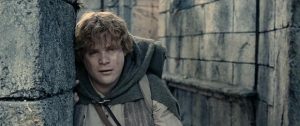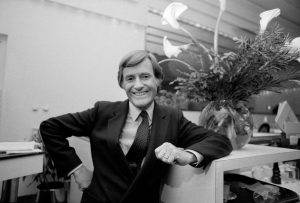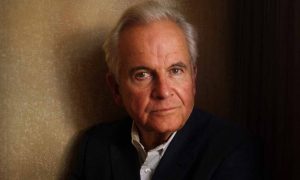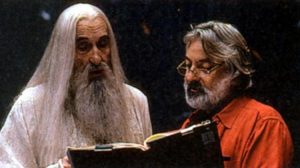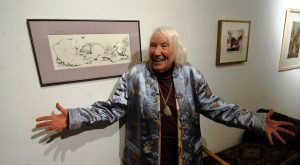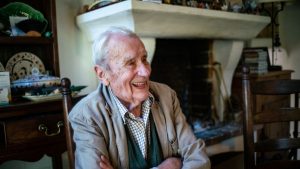SPOILERS FOR THE SILMARILLION AND POTENTIAL SPOILERS FOR THE RINGS OF POWER AHEAD!
The Lord Of The Rings: The Rings Of Power has long been believed to be the most expensive series ever made for either streaming or television. One season alone cost Amazon Studios an estimated $465 million dollars, and with two seasons already greenlit and a total of five planned (not to mention a potential spinoff), this is indeed shaping up to be a billion-dollar investment for Amazon; as initially reported when they obtained the rights to The Lord Of The Rings and its appendices in 2017 for a whopping $250 million.
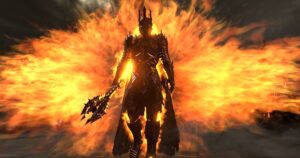
But what I and many other fans have wondered for a long time is whether there was more to the deal than Amazon or the Tolkien Estate told us at the time, because in the four years since that deal transpired, we’ve never once heard that Amazon planned to adapt The Lord Of The Rings itself. No, their interest lies solely in the book’s slim collection of appendices, specifically the first five pages of Appendix A, which offers an extremely abridged account of the Second Age of Middle-earth – the period of time in which Amazon’s The Rings Of Power takes place.
You heard that correctly: five pages of source material for a series that is supposed to run for five seasons. I suppose you could throw in the first three pages of Appendix B, and then you could round up all the various references to events in the Second Age found elsewhere throughout the appendices and the book, but ultimately you’re looking at something like…ten to fifteen pages, tops. Hardly worth $250 million dollars, if you ask me.
Unless there was more to the deal.
Look, I don’t want to downplay the significance of the appendices, because most of what we know about the early Third Age comes from Appendix A. But if you’re looking for a detailed account of anything that happens in the Second Age or earlier, there’s really only two places to look: The Silmarillion and Unfinished Tales. Although published several years after J.R.R. Tolkien’s death by his son Christopher, both of these books were stitched together from his notes and various rough drafts to compile the full story of Middle-earth from its creation to the end of the Third Age, focusing primarily on the First and Second Ages.
As a side-note, I highly recommend both books to anyone interested in the Tolkien legendarium, but be aware that neither is a novel. The Silmarillion is a dense historical text written in an archaic style reminiscent of the Old Testament – once you get the hang of it, it can be paradigm-altering, but I won’t fault anyone for page-skimming on their first read. Unfinished Tales actually contains a number of stories with rich characterization and a substantial amount of dialogue, but as the title suggests, very few of these stories are finished – which can make for a jarring reading experience.
Anyway, both of these books would be immensely helpful to the showrunners and writers on The Rings Of Power for the details they provide regarding the Second Age that are nowhere to be found in Tolkien’s other works, including the fullest account of the fall of Númenor and several slightly different versions of the tale of Galadriel, who had a front-row seat to the forging of the Rings of Power in Eregion and the War of the Elves and Sauron. And with every new piece of information we learn about The Rings Of Power, it looks more and more likely that Amazon has the rights to both these books.
This has not been confirmed by Amazon themselves, and by gifting editions of The Return Of The King (complete with its appendices) to members of the Tolkien community over the Christmas holidays, they’ve subtly maintained that they have the rights to those appendices and nothing more. But the math isn’t adding up. Because long before we ever got our first look at The Rings Of Power, place-names found only in Unfinished Tales were already popping up on the official map for the series and cast-members were pictured reading The Silmarillion. And when we did get our first official image from the series, it depicted a scene straight out of The Silmarillion.
According to TheOneRing.net and their occasionally reliable sources, Amazon possesses the rights to certain “elements and passages” from The Silmarillion and Unfinished Tales, and their theory is that this would include anything pertaining to the stories already summarized in the appendices to The Lord Of The Rings. But where does one draw the limit? The stories of Middle-earth are intertwined to such an extensive degree that, even in-universe, characters (usually Sam Gamgee, to be honest) are constantly remarking on how they’ve unexpectedly ended up in someone else’s story, or are affected by something someone did thousands of years prior. The great tales never end.
So today we’re looking at iconic characters and memorable events from The Silmarillion (and in a separate post, Unfinished Tales) that don’t feature in the appendices to The Lord Of The Rings, but which could still make an appearance in The Rings Of Power anyway. This is by no means a comprehensive list, but I wanted to choose characters and events that would be relevant to the narrative and themes of Amazon’s series – based on the limited information available to us.
1: The Ainur And The Ainulindalë

Most fantasy authors aspire to write a halfway decent book, publish it, and hopefully sell enough copies to write a sequel or two. J.R.R. Tolkien, in his early twenties, already had much higher ambitions. He wanted to create a national mythology for England, and he had Ideas for which of “the great tales” he would actually write, and which he would leave “only placed in the scheme, and sketched….[leaving] scope for other minds and hands, wielding paint and music and drama”. The Silmarillion was originally intended to be the backbone of this mythology; a quasi-religious text from which Tolkien hoped other artists and authors could draw inspiration for their own Middle-earth stories.
And like most religious texts, The Silmarillion begins with a good old-fashioned creation myth – The Ainulindalë – that takes its sweet time describing in painstaking detail the hierarchy and individual powers and attributes of the Ainur, Middle-earth’s pantheon of gods and deities. Tolkien wanted The Silmarillion to be ready for publication simultaneously with The Lord Of The Rings, so that readers intrigued by the scattered references to the Ainur in the latter novel could follow the trail back to where it all began – a bit like a glossary.
Unfortunately, he struggled to edit The Silmarillion into a book – and it wasn’t until after his death, when his son Christopher took on the daunting task, that the work was finally finished. As Christopher himself noted, the wait had been so long by that point that many readers had come to associate Tolkien’s style of worldbuilding with a sense of mystery that left endless possibilities for imaginative headcanons. Some fans, not won over by Christopher Tolkien’s dry, passable writing style, were disappointed to see their favorite gaps in the lore filled in so concretely – especially with regards to the Ainur.
And because The Silmarillion is typically not a book that even hardcore Tolkien fans read until after they’ve read The Lord Of The Rings once or twice, what was an issue in 1977 is still an issue now for many readers, who are almost invariably surprised to discover that Middle-earth has gods, if not weirded out by the lengthy descriptions of the gods and their casual interactions with humans. Be glad, then, that Christopher Tolkien actually cut out the pages and pages of exposition about the gods’ homes and interior décor (all of which I’m embarrassed to say I find fascinating).
But the Ainur are thematically significant to the overarching narrative of Middle-earth, and inextricable from the plot. Sauron is one of several characters sprinkled throughout Tolkien’s works who is actually a member of the Ainur, although by the time of The Lord Of The Rings, that detail had been forgotten by most and was not relevant to the story Tolkien was telling. In the Second Age, it’s vital information – I’ve written more extensively about Sauron’s backstory and the nuances of his character elsewhere, but I’ll just say this: if Amazon wants him to be the great villain that he surely can be, they need to tell audiences who he really is behind his various disguises.
OK, I’ll say a bit more, because I can’t help myself. Sauron’s character arc in the Second Age is intertwined with that of another Ainu, the fallen angel Melkor. In the beginning, Melkor had disrupted the harmonious music of the Ainur with his violent melodies, leading to a cosmic conflict that spanned the entirety of the First Age and ended with Melkor being cast into the void. But before he was forcibly removed from Middle-earth, Melkor influenced a number of lesser Ainur with his teachings, including Sauron. They were all given a chance to repent their sins after Melkor’s downfall, but Sauron refused out of humiliation for his defeat and bitter envy of the gods, and the rest is history.
Sauron’s goal was never to destroy the world but to create paradise on earth. When he proves unable to do so (because nothing perfect or beautiful can be created by evil), he decides to adopt Melkor’s nihilistic tactics and simply raze paradise instead, mustering a Númenórean army to invade the realm of the gods near the end of the Second Age with the empty promise that they can liberate Melkor from the void. The other Ainur are legitimately scared for their lives, and cry out to the one god above all others, Eru Ilúvatar, for help. He intervenes on their behalf, changing the shape of the world so that paradise is no longer accessible to humans.
Whether The Rings Of Power adapts The Ainulindalë specifically, I believe there is no better time for the Ainur to finally appear – explicitly, not merely in disguise – and for audiences to get a glimpse of the overarching cosmic narrative, the “majestic whole” linking all the stories of Middle-earth from The Silmarillion to The Lord Of The Rings. I also feel that Melkor and Eru at the very least should both be established as characters (or perhaps as mere entities, to preserve some of the mystery surrounding them and avoid potentially ridiculous character designs) long in advance of the cataclysmic events in which they take part.
2: Fëanor
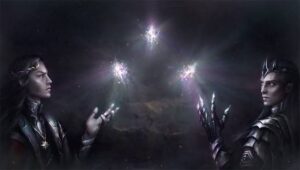
The first words in Appendix A of The Lord Of The Rings speak of Fëanor, the “greatest of the Eldar in arts and lore, but also the proudest and most selfwilled”. But the story of his life is only provided in summary as necessary context for the account of Númenor that follows, and readers interested in the character will find little information about him in the main text of The Lord Of The Rings, where Fëanor is mentioned a mere three times – his name uttered with reverence even by Gandalf himself. Only The Silmarillion tells the full tale; and what a tale it is.
Fëanor’s actions during the Years of the Trees and at the very beginning of the First Age of Middle-earth set in motion two conflicts that continued long into the Third Age; one a physical conflict between his family and…well, everybody, which claimed the lives of countless Elves including Fëanor and all but one of his seven famous sons; the other a metaphysical conflict, which was even more damaging to the Elves and lead to the eventual diminishment of their civilization and the dwindling of their people. Without him, the Rings of Power would never have existed, nor would the Elves have been tempted to make them in the first place.
After the beginning, but before time was being counted in years, the Elves lived in paradise alongside the gods and benefited greatly from their guidance and friendship. These were the Years of the Trees, when the sun and moon did not yet exist and the only natural light-source were the stars and the Two Trees of Valinor. The Two Trees were visible in the first official image from The Rings Of Power, released last year, which depicted an unnamed elf (now rumored to be Finrod) looking out over the Elven city of Tirion.
The most notable resident of Tirion was Fëanor, patriarch of a powerful (and exceptionally talented) family of blacksmiths, jewelsmiths, craftspeople, and inventors. Together, they designed intricate machines and incredible works of art – some of which, like the palantíri or Seeing Stones, survived into the Third Age and were weaponized during the War of the Ring. Fëanor was even able to capture some of the light of the Two Trees of Valinor and encase it within a set of jewels which he named the Silmarils. As Tolkien said, “Greatest of the Eldar in arts and lore”. In arts and lore. In all other regards…not the brightest bulbs in the box.
What Fëanor forgot, in his vanity, was that the Silmarils derived their radiance from the divine light within them – over which Fëanor had no rightful claim. So of course, when the Silmarils were inevitably stolen by Melkor, Fëanor took that as a personal insult and he and his family disobeyed the gods and pursued Melkor into Middle-earth. As a symbolic gesture, they also swore an unbreakable oath to never rest until they regained all three Silmarils. See what I’m saying? Rational thinking was not one of Fëanor’s strengths.
To be fair, no one could have known that he would spontaneously combust roughly five minutes later or that one by one, each of his sons would be dragged into the grave alongside him by the oath that chained them to his fate. But that didn’t stop regret and bitterness from setting in very quickly, particularly amongst the other Elves who had rebelled against the gods by following Fëanor and now found themselves stuck in a war-torn Middle-earth, forbidden to re-enter paradise. Even when the gods lifted the ban at the end of the First Age, many Elves refused to return – out of some mixture of shame, anger, and a fierce love for Middle-earth.
This is the volatile situation that Sauron took advantage of, by promising the Elves – including Fëanor’s gullible grandson, Celebrimbor – that they could repair the damage of the war they had brought with them, remake Middle-earth into a paradise more beautiful than that of the gods, and prove that Fëanor’s reckless quest for vengeance had been worth it in the end. This is something that resonates with many of the Elves, even those not fooled by Sauron’s lies. But the creation of the Rings of Power, bestowing upon their wearers the ability to slow the passage of time and prevent against decay, perfectly represents how their love was always misplaced.
Repeating the mistakes made by Fëanor, the Elves of the Second Age became possessive of Middle-earth, forgetting that it was never meant for them in the first place and that they had no power to control its fate. By refusing to leave, they placed themselves directly in the path of humans; the intended residents of Middle-earth. This coming-to-terms with the concept of mortality is an overarching theme of the Second Age, for Elves (who are immortal but must diminish and leave the lands they love) and for humans (who are literally mortal, “doomed to die”).
The final scene of The Lord Of The Rings finds Galadriel, Elrond, and many of the greatest Elves in Middle-earth boarding a ship bound for paradise – bringing to an end the time of the Elves, and clearing the way for humans. It is a sad moment, but a hopeful one as well, in which the Elves realize at long last that to love something, sometimes you have to let it go. But many fans, particularly of Peter Jackson’s films, describe this scene as confusing – because much of the essential context is only found in The Silmarillion. The Rings Of Power has an opportunity to change that by depicting Fëanor’s fall from grace, and I hope the showrunners take it.
3: The First Alliance Of Elves And Men

The prologue to The Lord Of The Rings, depicting the War of the Last Alliance between Elves and Men and the moment in which Isildur cut the One Ring from Sauron’s hand, thereby ending the Second Age and bringing about the Third, has become a staple of film adaptations of the story (granted there have only been two, but The Rings Of Power will likely show this moment a third time), but neither Jackson nor Bakshi had the time to try and explain why that Alliance was the last. It simply was, and that worked for the films because the story of The Lord Of The Rings doesn’t rely on an understanding of Elven interactions with Men during the First and Second Age.
But the first two episodes of The Rings Of Power are rumored to form one three-hour long prologue to the main events of the series, and something I sincerely hope that’s included in that prologue is some mention or reenactment of the first meeting between Elves and Men, because frankly I don’t know how you can tell the story of the Second Age without establishing that Elves and Men used to be the closest of allies. It’d be like launching into the story of A Christmas Carol without first clarifying, beyond a shadow of doubt, that “the Marleys were dead to begin with”.
Men were born with the first rising of the sun, at the beginning of the First Age – very soon after the death of Fëanor, in fact. Following the sun, they traveled westward across Middle-earth for some three-hundred years, to the lands of Beleriand where the Elves were then living. And it was there that a group of Men under the leadership of Balan were discovered one evening by Finrod Felagund, the lord of Nargothrond, who crept warily into their camp and, moved by sudden love for these strange people, took up a harp and sang to them of the blessed land.
Finrod, as I’ve mentioned, is believed to be the character seen in the first image from The Rings Of Power. He was the elder brother of Galadriel, but one of the youngest lords in the host that left paradise – and he had not gone out of love or loyalty to Fëanor, but rather out of fear that Fëanor would lead the Elves astray. In Middle-earth, however, he found a new purpose helping the first Men, welcoming them into his kingdom and teaching them the skills they would need to build their own civilizations. While his fellow Elves were busy clinging to what they had, Finrod was already preparing to relinquish dominion of Middle-earth to Men.
Assuming Finrod is onscreen for more than five seconds (and assuming that’s even Finrod in that screenshot), his meeting with Balan is a scene that we could expect to see in the first episode – hopefully followed by some kind of montage depicting their life together, because there are very few characters in Tolkien’s legendarium who come quite as close to being canonically queer as Balan, the man who abandoned his people to go live with Finrod after spending a couple of days with the guy, and made the intriguing decision to change his name to Bëor (literally, ‘Vassal’ or ‘subordinate’).
Platonic or not, their relationship was so close that Bëor’s entire extended family also swore loyalty to Finrod, and he honored them all with the title of “Elf-friend”. Throughout the First Age, Elves and Men working together beat back the forces of Melkor just long enough for a mariner named Eärendil (himself a half-Elf, born to a human father and Elven mother) to journey across the sea to the realm of the gods with a plea for help. He was successful in his mission, and the gods defeated Melkor, but as Tolkien was no doubt well aware, winning the war is sometimes less difficult than picking up the pieces afterward.
The gods came between Elves and Men, but from the night they first met in Beleriand it was probably inevitable that they would clash over the subject of mortality. In The Silmarillion, we see the first death of a man from the perspective of the Elves, who are startled and saddened when Bëor suddenly dies at the age of ninety-three – still extremely young by Elf years. We don’t see the reaction from Men to the revelation that Elves don’t die, but that’s something I hope The Rings Of Power remedies; thus planting the seeds for the conflict that will define the Second Age.
4: The Death Of Finrod Felagund

Elves don’t die, but they can be killed, and the wars with Melkor claimed thousands of lives. It was an especially unhappy time for people whose names began with F, as Fëanor, Fingolfin, Fingon, Finduilas, and Finrod Felagund at various points all fell victim to Melkor and his minions. I could be here all day recounting the events that led up to each of their deaths, but we don’t have time for that and I highly doubt The Rings Of Power has time for that, even in a three-hour long prologue. Gotta save some stuff for the inevitable First Age spin-off series, am I right?
But out of all the characters listed above, there’s just one whose gruesome death would (a) clearly convey the unforgettable horror and personal tragedy of the wars with Melkor, specifically for the rumored main character of The Rings Of Power, Galadriel, (b) firmly establish the genuine threat posed by Sauron while revealing to the general audience that he was once the servant of an even more terrible Dark Lord, and (c) cap off what could otherwise be a slow-moving, exposition-heavy prologue with a cool and distinctly unique action sequence.
That character is Finrod Felagund. Ah, sweet, kind, selfless Finrod; always ready and willing to put his own life in danger to protect people he barely even knew. Fittingly, it was a Man – Beren of the House of Bëor – whom he died defending, while the two were being held prisoner by Sauron in the werewolf-infested ruins of Finrod’s old fortress on the island of Tol Sirion. For reasons that I feel have never been adequately explained, Sauron spent most of the First Age breeding werewolves on Tol Sirion. At some point he must have stopped, because werewolves seem to have died out by the time of The Lord Of The Rings, but he was obsessed with them for a long time.
Finrod and Beren fell into Sauron’s hands while trying to sneak past Tol Sirion with a company of Elves disguised as orcs. Sauron, a literal shapeshifter and master of illusions, wasn’t fooled for an instant, and “chanted a song of wizardry” to reveal the truth. What followed was a magical contest unlike anything else found in Tolkien’s works, with Finrod singing a song of paradise to defy Sauron and strengthen the spell that hid them. In response, Sauron sang of the shame of the Elves and of Fëanor’s rebellion that had destroyed the peace of paradise, and ultimately defeated Finrod, leaving him and Beren “naked and afraid”.
Then Sauron chained Finrod, and he tossed the Elf and his companions into a deep pit beneath Tol Sirion – and from time to time he would send a werewolf down into the pit to devour one of the companions, until only Finrod and Beren were left. The werewolf came one last time, and this time it came for Beren; but Finrod (who mind you, was completely naked and probably already dying of starvation and thirst) broke his chains using only his raw strength, grabbed the werewolf, and killed it “with his hands and teeth”, which to my mind implies that he…disemboweled the creature? Strangled it? Either way, it was gory and epic.
He died, of course, but saved Beren’s life, and in that same hour Lúthien came to Tol Sirion looking for Beren, and she battled Sauron, using her own magic to defeat the lord of werewolves and bring down the fortress. Sauron was forced to go into hiding, lurking in bat-form in the woods of Dorthonion where neither the Elves nor the wrath of Melkor could reach him. It wasn’t until Lúthien was dead and Melkor was defeated that Sauron finally reappeared at the dawn of the Second Age. Still, he had brought about the death of Finrod, and that was a terrible blow to the Elves.
In Nargothrond, Finrod’s death led to a conflict over succession between his regent Orodreth and the powerful sons of Fëanor who had hoped to usurp the throne. Galadriel’s reaction to her brother’s death is not recorded, and Tolkien wrote so many different versions of her story that it’s difficult to even pin down where she was at the time, but it could have been roughly around this point that Galadriel ventured further into Middle-earth, leaving Beleriand and the War with Melkor to others.
Galadriel will be a major character in The Rings Of Power, and for her not to mention Finrod at any point throughout the series would be very surprising to me – especially seeing as she crosses paths with Sauron during the Second Age and has a rare opportunity to interact with him face-to-face, while he is still cleverly disguised as an Elf and she is trying to figure out who he really is behind his façade. The situation is different, and the roles are reversed, but there’s an intriguing parallel there to Finrod’s unsuccessful deception of Sauron, and it would be poetic if Sauron’s undisguisable disdain for Finrod was what ultimately broke the illusion.
5: The War Of Wrath
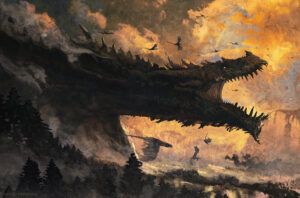
The First Age of Middle-earth ended in a brief, tumultuous conflict called the War of Wrath by the Elves – and according to Tolkien, they wrote few tales about it because they did not take part in it, and only witnessed from afar the clash of Melkor’s horde with the mighty host of the Ainur summoned out of the west by Eärendil. I have a suspicion that this was partly an excuse to get out of writing about the war itself, as Tolkien later made a habit out of knocking his characters unconscious right before battles, but the truth is that the gods had no military strategies, no battle plans, nothing from which an author could form a detailed account of this war.
The War is largely described in broad terms: “The evil realm was brought to naught….the northern regions of the world were rent asunder….there was confusion and great noise.” The fury of the gods was so terrible that they broke the land of Beleriand beneath their feet, and all its inhabitants fled further into Middle-earth (where they reunited with Galadriel, who had been chilling out in Lindon for the last century or so). But the only moment from this War of Wrath that Tolkien describes in much depth is the duel between Eärendil and the great dragon Ancalagon, who crushed Melkor’s mountain fortress beneath him when he fell from the sky.
Melkor was tossed into the Void, the Silmarils were placed forever beyond the reach of the Elves, the last son of Fëanor disappeared into self-imposed exile, and the Second Age began. It was a time for rebuilding, a time of hope and joy and celebration. Too bad the gods’ misguided attempts to strongarm Elves and Men into throwing away the last several hundred years of collective growth and development in favor of a ‘return to normalcy’ would ultimately result in another conflict that would span the next three-thousand years.
The gods were at first unconcerned with Men. They gave them an island all to themselves as compensation for their sacrifices, because they trusted that Eru Ilúvatar had a plan for the human race, and they knew that humans needed to proliferate to achieve that plan, but their primary goal was getting the Elves out of Middle-earth before that happened and bringing them back across the sea to paradise. Many Elves refused to go back, but with the ban finally lifted, the fates of Elves and Men began to diverge.
This caused a lot of problems for Men, who understandably wanted to check in with their Elven friends who had departed across the sea, only to be informed that they weren’t even allowed to sail “so far westward that the coasts of Númenor could no longer be seen”. At first, they respected this ban and were content with receiving occasional Elven visitors from paradise in Númenor’s western port cities, but gradually the uneasy feeling that they were being excluded from something gave rise to rumors that the secret to immortality could be found in paradise, but that the gods would not share it with Men.
As they watched more and more of the Elves return across the sea to paradise, forsaking the land over which they had fought and spilled their blood together, it’s easy to imagine how the Númenóreans must have felt – but their growing envy of the Elves and fear of their own fate led to indefensible and increasingly irrational acts of violence as they tried to ward off death with dark magic and necromancy, or desensitize themselves to it by slaughtering the inhabitants of Middle-earth. By time Sauron came among them, they were already on the brink of breaking ties with Elves and gods entirely.
Sauron exploited the situation, just as he did with the Elves, and convinced the Númenóreans that they could obtain immortality by force from the gods. At this point, you’d think that the gods would maybe want to step in and quietly remove Sauron from the picture, but nah, they let him openly butcher Elf-friends and prisoners of war on an altar dedicated to Melkor for years while only occasionally communicating their displeasure via eagle. To the surprise of absolutely no one, Sauron was able to persuade the Númenóreans into attacking paradise, at which point the gods finally responded by…opening a chasm under the island to swallow it whole.
Much of this could have been avoided, perhaps, if the gods had not been so obsessed with trying to divide Elves and Men across two separate continents that they accidentally caused them to fear and hate each other, or if they had devoted literally any of their infinite time and energy to locating Sauron and Melkor’s other lieutenants instead of giving them freedom to roam across Middle-earth. Or perhaps not. Tolkien’s works allow for multiple, equally valid readings, and it’s important to remember that The Silmarillion is told from an Elven perspective, and Elven biases are intentionally engrained into it.
Whichever angle The Rings Of Power takes, blaming gods, Elves, Men, or all of the above, the events of the War of Wrath (and its immediate aftermath) are a vital prelude to the fall of Númenor. Besides that, there’s an opportunity to show off the largest dragon ever (and director J.A. Bayona has plenty of experience with giant reptiles), and for some truly groundbreaking action sequences. The fact that Amazon’s official map for The Rings Of Power also draws attention to the scattering of islands left over from Beleriand after the War of Wrath suggests that this is something we will see early in the series, and I couldn’t be more excited.
So what do you think of the points on my list? Stay tuned for part two of what may or may not be an ongoing series (is The Akallabêth long enough to warrant a whole separate post?), and as always, share your own thoughts, theories, and opinions, in the comments below!
